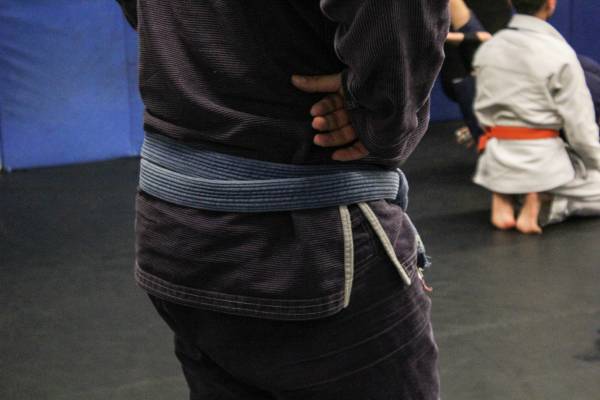
Which Brazilian Jiu-Jitsu belt is the hardest one to get? I guess that would be the black belt. However, despite what people might think, the black belt is actually not the belt people crave the most. The most desired belt of all is the BJJ blue belt. Why? The answer is simple – nobody likes to be a beginner at anything. That said, most folks so desperate for that coveted blue belt have not idea what’s waiting on the other side. If there’s one belt where people endure the most difficult of times, it is the blue belt. And this is our ultimate survival guide to get you through it.
The BJJ blue belt is a huge milestone and exciting time for grapplers. It is also the ultimate test of perseverance. If you can make it through a blue belt, it is safe to say you’ll stick around and become a lifetime grappler. However, making it through is the tricky part. Bleu belt often ends up being the longest time you’ll spend at a certain belt level. Moreover, it is the one time people massively quit BJJ. No wonder the blue belt blues gets so much attention. To be honest, being a blue belt is tough, challenging, and in great measure demoralizing. However, there are ways of getting through it. And trust me when I say, it is better on the other side.
Blue Belts Are Not Food.. Or Are They?
One very common BJJ quote is that “blue belts are not food”. AS things stand, if there’s a need to say this in a quote, then people do see them as food. And by people, I mean purple belts and above. Blue belts are usually those that get most of the attention during rolling. They’re not white belts that pose no challenge to the higher belts. However, they’re also not at their level, or above, and as such, provide a great way for higher belts to try stuff out. The thing is, most of that stuff is not very blue belt friendly.

In all honesty, I can’t claim that this approach is the wrong one. Of course, I didn’t particularly admire it when I was a blue belt myself. And just like everyone else, I saw blue belts as food for most of my time at the purple belt. Still, that all-important grit and defensive mindset are the two things anyone in BJJ has to learn. And the blue belt is the perfect time to do so.
The Ultimate Survival Hack For The BJJ Blue Belt
When I say survival, I mean surviving in the literal sense of the word. Even with more experienced white belts, blue belts have their hands full .there’s a very good reason for this. As a BJJ blue belt. You still have no idea how timing, weight distribution, trap setting, and other key concepts work .instead, you’re too focused on gathering as many techniques as humanly possible. That’s all well, but you’ll soon end up quitting if all you do is tap out and struggle for a couple of years. Instead, keep doing what you’re doing, but start doing it defensively. In other words, the one key thing you need to learn at a blue belt is how to defend against attacks. Don’t worry though, that doesn’t mean not doing any attacking of your own.
The one biggest lesson I always try to teach blue blets is to smile. The idea behind this is easy. when you smile, you can’t have a clenched jaw. conversely, if your jaw is not clenched, your neck and body can stay relaxed. That means you can think about what you’re doing without having to collapse in a heap after every roll.
The tactics here are, to survive before you attack. The one thing most common for blue blets is to try and defend everything, often to great success. What they fail to do, though, is act upon that successful defense. So, try and approach things this way – stay safe first, completely off the bat. Keep smiling to stay relaxed and make sure that every time you defend something you try and see how you could use the same movement to launch a counter-attack. That’s it. You don’t actually have to succeed. It is enough to help you turn defense into attacks, and survive the toughest period in BJJ.
Moving Out Of Survival Mode
Speaking of the toughest period in BJJ, there’s also a catch. As a BJJ blue belt, you’re expected to become progressively more and more difficult to submit. However, if all you do is defend, there’s no way to progress. Many people make the mistake of becoming too comfortable in just defending, and end up as blue belts for much longer than needed. Here’s another hack – instructors are going to wait for you to open up your game after you become sound defensively before they’re even going to consider promoting you to a purple belt.

Closing Arguments
The BJJ blue belt is a huge thing for anyone training JIu-Jitsu. It is a tough time, granted, probably the toughest time you’ll have. Still, the lessons learned at this level are immense, and they carry over to everything you do later on. Survival is the basis of grappling since you can’t do anything unless you know how to stay safe. Learning this as a blue belt means you’ll always have a safety net when you roll, which will make it a lot easier for you to open up your game as a purple belt.
Related Articles
- Blue Belt requirements, struggles, and expectations
- BJJ Blue Belt Requirements and Curriculum
- 5 Main reason why people quit at Blue Belt
- Blue Belt mistakes caused by white belt habits
- What if you feel you’re not Ready For Your Blue Belt
- A practical blueprint for the journey through Brazilian Jiu-Jitsu


![Darce Choke Encyclopedia – Origins, Mechanics and Variations [2025] BJJ, choke, Brabo, BJJ Darce Choke, D'arce Choke, Darce BJJ Choke](https://bjj-world.com/wp-content/uploads/2017/11/JungPoirierLeeYahoo-218x150.jpg)









![Leg Lock Entries Helena Crevar DVD Review [2025] Leg Lock Entries Helena Crevar DVD Review](https://bjj-world.com/wp-content/uploads/2025/03/leg-lock-entries-helena-crevar-dvd-review-218x150.png)
![Special K Guard Neil Melanson DVD Review [2025] Special K Guard Neil Melanson DVD Review](https://bjj-world.com/wp-content/uploads/2025/03/special-k-guard-neil-melanson-dvd-review-218x150.png)
![Arm Bar It All Shawn Melanson DVD Review [2025] Arm Bar It All Shawn Melanson DVD Review](https://bjj-world.com/wp-content/uploads/2025/03/arm-bar-it-all-shawn-melanson-dvd-review-218x150.png)


![Advantage Over Time Outside Passing Jozef Chen DVD Review [2025] Advantage Over Time Outside Passing Jozef Chen DVD Review](https://bjj-world.com/wp-content/uploads/2025/03/outside-passing-jozef-chen-dvd-review-218x150.png)
![No-Gi Pressure Mastery JT Torres DVD Review [2024] No-Gi Pressure Mastery JT Torres DVD Review](https://bjj-world.com/wp-content/uploads/2024/10/no-gi-pressure-mastery-jt-torres-dvd-review-324x235.png)






![Leg Lock Entries Helena Crevar DVD Review [2025] Leg Lock Entries Helena Crevar DVD Review](https://bjj-world.com/wp-content/uploads/2025/03/leg-lock-entries-helena-crevar-dvd-review-100x70.png)

![Henry Akins Black Hole No-Gi Closed Guard DVD Review [2024] Henry Akins Black Hole No-Gi Closed Guard DVD Review](https://bjj-world.com/wp-content/uploads/2024/09/henry-akins-black-hole-no-gi-closed-guard-dvd-review-100x70.png)

![Trip Throw Dilemma Michael Pixley and Heath Pedigo DVD Review [2024] Trip Throw Dilemma Michael Pixley and Heath Pedigo DVD Review](https://bjj-world.com/wp-content/uploads/2024/10/trip-throw-dilemma-michael-pixley-dvd-review-100x70.png)



![Welcome To The Darce Side Travis Moore DVD Review [2025] Welcome To The Darce Side Travis Moore DVD Review](https://bjj-world.com/wp-content/uploads/2025/01/welcome-to-the-darce-side-travis-moore-dvd-review-100x70.png)
![No-Gi Defense Xande Ribeiro DVD Review [2024] No-Gi Defense Xande Ribeiro DVD Review](https://bjj-world.com/wp-content/uploads/2024/11/no-gi-defense-xande-ribeiro-dvd-review-100x70.png)
![The Empty Half Guard Michael Currier DVD Review [2025] The Empty Half Guard Michael Currier DVD Review](https://bjj-world.com/wp-content/uploads/2025/03/empty-half-guard-michael-currier-dvd-review-100x70.png)

![Master The Move The American Lock John Danaher DVD Review [2024] Master The Move The American Lock John Danaher DVD Review](https://bjj-world.com/wp-content/uploads/2024/12/the-american-lock-john-danaher-dvd-review-100x70.png)
![Complete Fundamentals Curriculum Eliot Marshall DVD Review [2025] Complete Fundamentals Curriculum Eliot Marshall DVD Review](https://bjj-world.com/wp-content/uploads/2025/02/fundamentals-curriculum-eliot-marshall-dvd-review-100x70.png)

![10th Planet Leg Locks Jeremiah Vance DVD Review [2025] 10th Planet Leg Locks Jeremiah Vance DVD Review](https://bjj-world.com/wp-content/uploads/2025/01/10th-planet-leg-locks-jeremiah-vance-dvd-review-100x70.png)
![I Got Your Back Jake Straus DVD Review [2025] I Got Your Back Jake Straus DVD Review](https://bjj-world.com/wp-content/uploads/2025/03/i-got-your-back-jake-straus-dvd-review-100x70.png)
![Wristlocks From The Top Pete Letsos DVD Review [2025] Wristlocks From The Top Pete Letsos DVD Review](https://bjj-world.com/wp-content/uploads/2025/01/wristlocks-from-the-top-pete-letsos-dvd-review-100x70.png)

![Back Hacks Yigit Haney BJJ DVD Review [2025] Back Hacks Yigit Haney BJJ DVD Review](https://bjj-world.com/wp-content/uploads/2024/12/back-hacks-yigit-haney-bjj-dvd-review-100x70.png)
